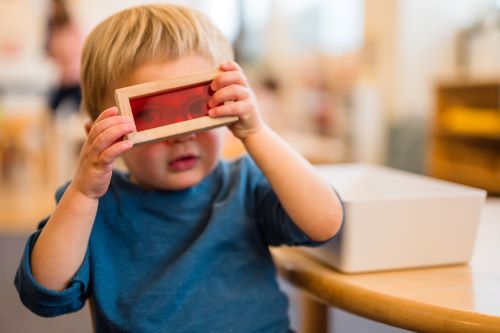To look through the lens of a child is to see a fresh view on the world. Early educators, especially, have the opportunity to witness this daily. The prejudices that many adults obtain from years of living are not evident in younger children. This can produce a viewpoint that is free from knowledge of past experiences. For example, a child who eats a strawberry for the first time will eat the fruit not knowing if the taste will be preferred. The adult is probably aware if the strawberry tastes good or not. Going into situations with little to no prejudices can have its benefits. In a classroom setting the child will learn new concepts including those involving academics. When something new is presented to the child, because there is no previous experience, the child can look at this concept from a fresh lens. The child could see different ways to view something new. These new views could also be new to the teacher, thus teaching something to the educator.
A student who is learning something new for the first time will notice specific details about a lesson that the adult did not realize existed. For example, in a Montessori environment children are taught to clean up after themselves at a young age. It is common to instruct a three-year-old to sweep a mess off the floor. When the child experiences using a broom and dustpan for the first time then this activity becomes amusing. For an adult, or even an older child who has swept many times, this task has lost its novelty. It is now seen as a chore and not a privilege. Through the young child’s eyes, sweeping is now exciting. Every piece of dirt, dust, or particle might be spotted by the young student, something that an adult who sees this task as tedious might not have noticed.
This is also true during a student led observation. Children will be able to spot a bird high up in a tree or the color of a newly painted building that is passed everyday. Children teach adults to slow down and examine the surroundings, to stay in the present.
Children solve problems in the way that corresponds to their stage in development. This can be different from the way an adult thinks, because of past experiences. The educator or the student can start teaching the new concept in a way that makes sense to the student’s peers. Because early educators have to break down rudimental skills—skills that have been mastered for some time for adults—it is almost necessary to understand where to break these skills down. The logical way to teach a student might not be so logical to an adult. Through peer learning, children will have the opportunity to understand concepts in a way that is understood.
When children of the classroom become leaders and teachers to peers, then the educator can start to learn from the students. It is important for the teacher to observe during these times because that is when new lessons can be created. Learning from peers will produce confidence in the child that is teaching and the student who is receiving a lesson will start to build meaningful relationships. The importance of being accepted by peers grows as the child gets older. Watching peer learning will also teach the educator to observe the classroom more frequently. Through observation, the teacher will learn habits from the students, habits that might be encouraging misbehavior in the classroom from the students. Also, the educator can learn the ways in which they need to elevate their own practice perhaps to be more inclusive or acknowledge their own biases. Now that the source of the misbehavior is pinpointed, the teacher can start to use preventative tactics in the classroom.
The best way to avoid misbehavior in a classroom is by prevention. Observing the environment, especially during times that are challenging, will give the educator insight in how to make the classroom run smoothly. When children are not respecting boundaries it is their way of communicating a need to the adults. This can be that they are bored in the classroom, they need more one-on-one attention, they are hungry, tired, not comfortable in the environment or their identity is not being validated in the environment. The teacher has to listen, figuratively and literally, when misbehavior does occur. The child will be able to teach the educator about themselves and what they need to be successful in the classroom.
A teacher in a traditional school setting is the one that stands in front of the classroom and instructs students on how to learn and behave. Some educators act as a guide to direct a young curious child down the path of academics. Teaching goes both ways for everyone involved in the classroom. The students have a pure way of thinking and through a child’s eyes an adult can learn many things.
About the Author
 |
Saniyyah Khalilallah worked in a Montessori classroom for over a decade, first as an assistant and then later as a certified guide (Primary, 3 – 6 years). Now, she is writing books for children, consulting, and tutoring. Contact her at skmontessori.com or saniyyahkhalilallah@gmail.com. |
The opinions expressed in Montessori Life are those of the authors and do not necessarily represent the position of AMS.


